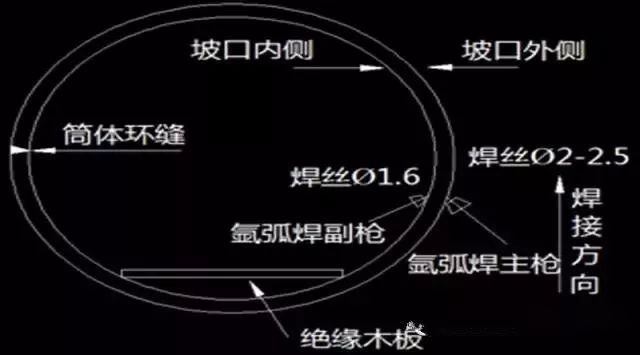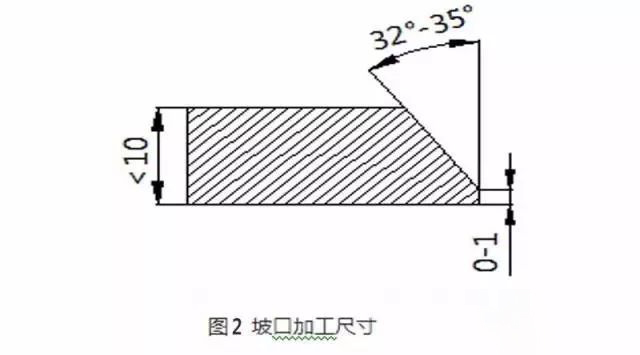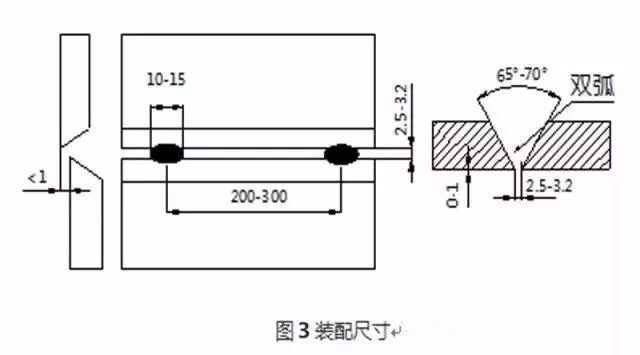The welding quality of the welding seam of the stainless steel pressure water tank directly affects the safety of the pressure vessel. There are many welding methods, argon arc welding is one of the ideal welding methods, but when the diameter is greater than 800mm and the volume is relatively large, the internal argon filling protection brings certain difficulties and increases the production cost. The double-arc argon arc welding process is mainly used for the welding of the circumferential seam and longitudinal seam of the container, which significantly improves the welding quality and welding efficiency and reduces the production cost.
The barrel adopts the double-sided double-arc bottoming welding process of argon arc welding, and the workpiece is made into a single-sided V-shaped groove. In the vertical position, two welders and two independent power sources are used to connect the inner and outer sides of the workpiece with the molten pool. welding. After the bottom welding, the filling and cover welding are completed with a single arc. Eliminates the previous procedure of filling argon on the reverse side and reduces the root cleaning process on the back side; it has good weldability and can effectively control the height of the reverse side weld; because the double arc increases the stirring ability of the molten pool and the fluidity of the molten pool, it can make the molten pool fully Fusion reduces defects such as slag inclusions, pores, and incomplete penetration; it has the characteristics of small heat input, small welding deformation, reduced joint stress, and significantly increased penetration.
Assembly requirements
1.1 Use a special platform during assembly to isolate it from other metal materials such as carbon steel; avoid scratches caused by collision during transportation; special slings and fixtures, such as nylon belts, must be used for lifting, and steel wire ropes are strictly prohibited to avoid scratching the metal surface.
1.2 Select qualified plates in strict accordance with the design requirements of the drawings, determine the actual size of each material, use plasma cutting or machining to cut the material, and the grooves should be prepared by machining or grinding methods. For processing, the head is beveled by a grinder, and the specific dimensions are shown in Figure 2
After the processing is completed, three-wire rolling is used for arc processing. The assembly size is shown in Figure 3. Clean up 10~15mm on both sides of the groove, the assembly gap is 2.5~3.2mm, the offset of the plate is less than 10% of the wall thickness, and not more than 1mm, using argon arc welding, length 10 ~15mm, thickness 3~4mm. The arc initiation and arc termination must be carried out on the groove face. After assembly, use a polisher to polish the front and back of the solder joints to see the luster.
1.3 During assembly, avoid forced assembly to reduce the internal stress of components. Try to avoid other objects contaminating or scratching the surface of the board.
It is forbidden to randomly strike arcs or randomly weld and install temporary components on the surface of the cylinder. The surfaces on both sides of the weld should avoid using a hammer to correct it.
Welding process
2.1 Preparation before welding
Clean up the rust layer, moisture, oil, dust, etc. 10-15mm on both sides of the groove.
2.2 Selection of commonly used welding consumables (see Table 1)
| Base metal | Welding wire |
| SUS 304 | ER 308 |
| SUS 304L | ER 308L |
| SUS 316 | ER 316 |
| SUS 316L | ER 316L |
| SUS 321 | ER 321 |
Welding parameters (see Table 2)
| Base metal thickness (mm) | Wire diameter (mm) | Welding surface | Current type and polarity | Welding current (A) | Gas flow (L/min) |
| 4-10 | Φ1.6 | Non-groove | DC positive connection | 20~50 | 6~10 |
| Φ2~2.5 | Bevel face | DC positive connection | 70~110 | 8~10 |
2.3 Welding precautions
Choose the appropriate welding material according to the plate, use Φ1.6mm welding wire inside the weld, welding current 20~50A, outside choose Φ2~2.5mm welding wire according to the thickness of the plate, welding current 70~110A, and use low current fast welding for bottoming. Filling and capping layers should choose welding methods such as argon arc welding, electrode arc welding, and CO2 gas shielded welding according to specific conditions. When the plate thickness is less than 10mm, try not to use submerged arc automatic welding.
2.4 Welding inspection
After 48 hours of welding, film and color non-destructive testing of the welding seam is carried out. This process adopts double-arc argon arc welding for bottoming, argon arc welding for filling the cover surface, welding seam filming and non-destructive testing of coloring are all qualified, and the bending test, tensile strength test and intergranular corrosion test all meet the specified indicators.
2.5 Post-weld treatment
After non-destructive testing and strength test, pickling and passivation treatment are performed on the weld and the near seam area.
The bottoming process of double-sided double-arc argon arc welding of stainless steel is one of the ideal welding methods. As a high-efficiency, energy-saving, high-quality and economical welding process, double-arc welding has good application prospects in actual production.
Post time: Jun-13-2022




